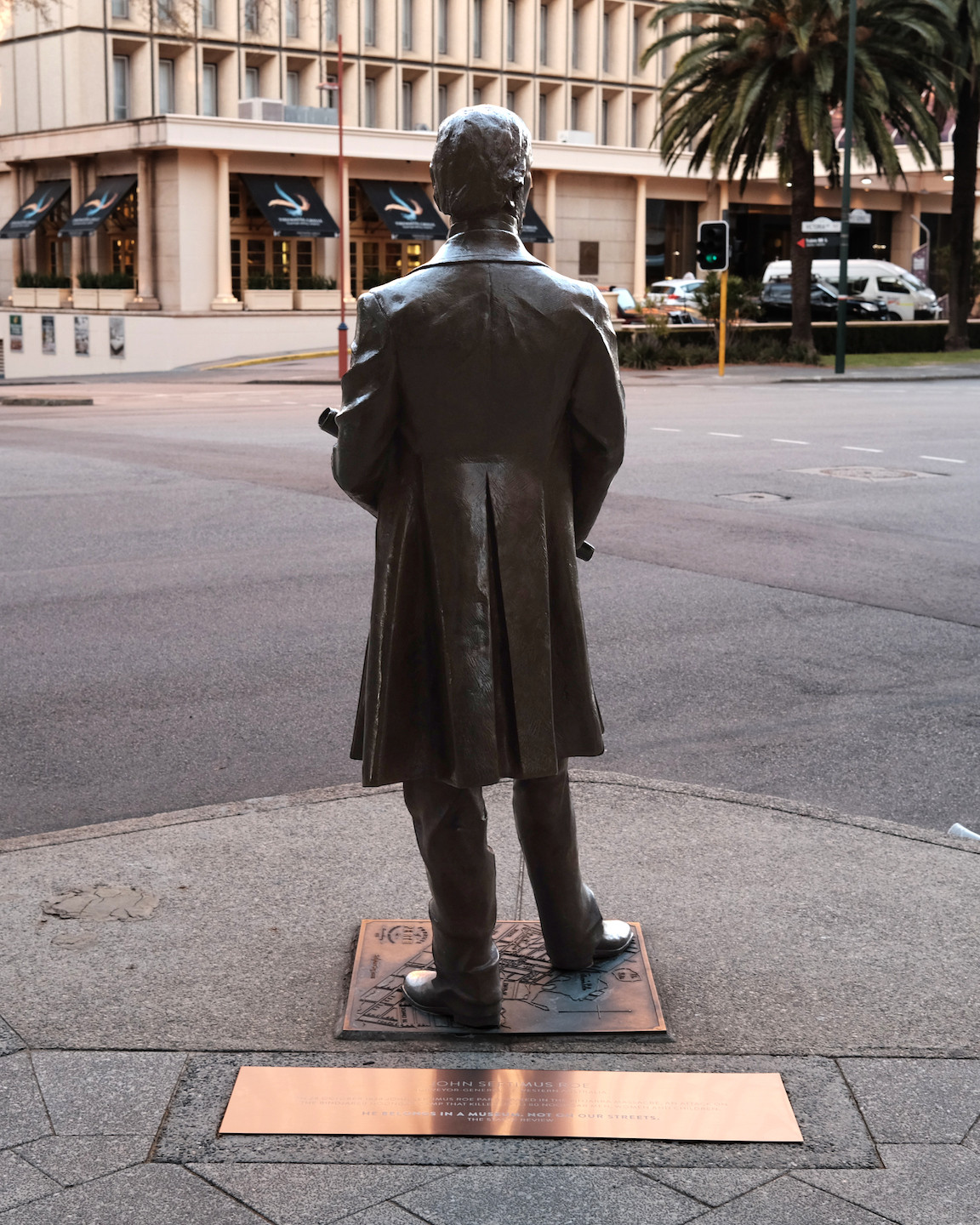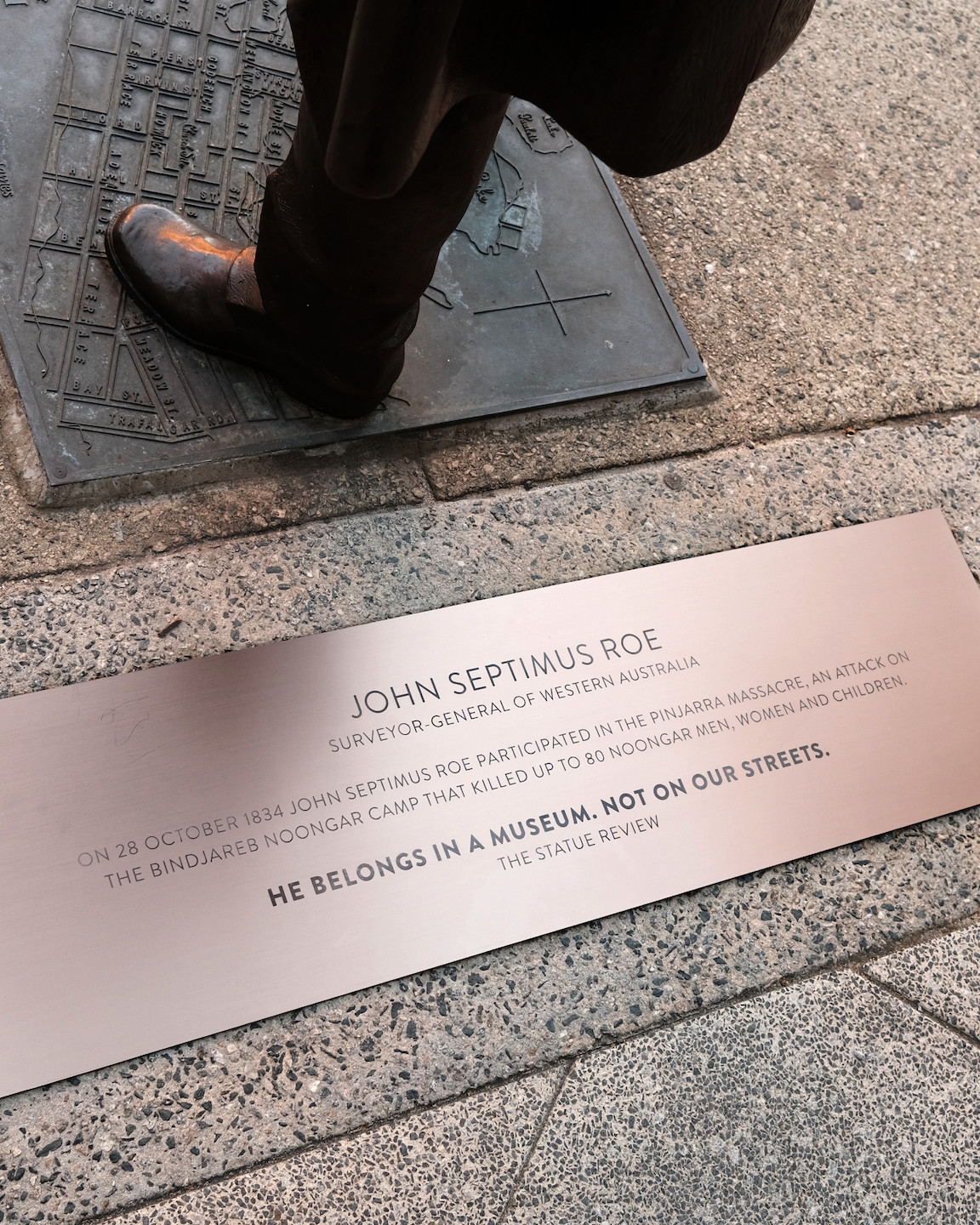
Australian Activists Give Racist Statues New Plaques to Highlight Colonial Violence
September 16, 2020An Australian art collective set out to “rewrite history” over the weekend by attaching bronze-acrylic plaques to statues of prominent colonial figures in the country’s southwest city of Perth.
John Septimus Roe, whose statue stands at the busy corner of Victoria Avenue and Adelaide Terrace in the heart of the city, was the first Surveyor-General of Western Australia and a member of Western Australia’s legislative and executive councils for almost 40 years.
As the newly-cut plaque sitting at the statue’s feet now adds, however: “On 28 October 1834, John Septimus Roe participated in the Pinjarra Massacre, an attack on the Bindjareb Noongar camp that killed up to 80 Noongar men, women and children.”

Captain James Stirling, a British naval officer and colonial administrator whose statue stands on Hay Street, in Perth’s CBD, participated in the same massacre. The plaque now attached to that statue announces the same.
“He belongs in a museum,” both plaques read. “Not on our streets.”
Stirling’s effigy was only recently defaced amid Black Lives Matter protests in Perth, with activists colouring its neck and hands red in protest of the fact that such a controversial figure, who played an active part in the murder of dozens of Indigenous Australians, had been immortalised and idolised in the centre of one of the nation’s capital cities.
Before this weekend, however, there was nothing about Stirling or Rose’s statues themselves that informed the daily passersby of the misdeeds and atrocities these men committed in their lifetimes.

“It's still absurd that we walk past these statues every day and no one thinks of them as murderers,” a member of The Statue Review, the arts collective behind the plaques, told VICE News. “The statues adhere to the philosophy: ‘If you can’t see the problem, It doesn’t exist’. So we set out to tell both sides of the story.”
The artist—who asked not to be named—explained that the aim of the project was to “highlight the absurdity of a White Australia” and bring attention to little-known parts of the federation’s history that aren’t typically taught in schools.
And with the City of Perth Mayoral Elections coming up in mid-October, the time seemed right to start raising questions around the statues and the kinds of figures that Australia’s decision-makers have historically chosen to celebrate.
“We’d like to hear what the candidates’ stance is on glorifying people who partook in ethnic cleansing on the streets of our capital city—and if they would be willing to relocate the statues to a museum if elected,” they explained. “Statues in the street tell us one thing: that the man in bronze is a hero. But if the statue was moved to the museum, it would be seen as history and something we could learn about from both sides.”
The WA artists are far from the first to suggest that monuments to Australia’s colonial figureheads, who were instrumental in the displacement of and systemic violence against the country’s First Nations people, might be more appropriately placed within the context of a museum. In July, dozens of academics, artists, curators, and Aboriginal and Torres Strait Islander figures signed an open letter to the City of Sydney asking that the Captain James Cook statue in Hyde Park be relocated to a public museum.
“What Cook represents, his continuing legacy in First Nations peoples’ dispossession and social injustice, perpetuates suffering,” read the letter, published in The Saturday Paper on July 4. “Public spaces such as Hyde Park should be welcoming to all … the statue’s proper place is in a public museum where its historical and aesthetic contexts can be better understood, displayed and conserved.”
“By relocating historic colonial statues to inside the museum, artworks such as [Thomas] Woolner’s Cook [statue] can be revalued, our beliefs about them rethought, and our attachments to them challenged,” it concluded. “Let the museum speak of the past; things must change in order for truth to be heard and future histories made.”
A week later, Sydney Mayor Clover Moore pledged that the city’s council would “consult with our Aboriginal and Torres Strait Islander Advisory Panel and local elders, and engage the wider community in a mature conversation about our colonial past” before making a decision on what should happen to Sydney’s colonial statues.
Overall, responses to the plaques that were affixed to Perth’s colonial statues over the weekend have been relatively positive. A photo of the amended Stirling statue has attracted hundreds of comments on Reddit over the past 24 hours, many of them praising the peaceful nature of the activists’ statement and the fact that they chose not to “cancel” the statue.
At the same time, many agreed that it would be more appropriate to put the statues in a museum where people could be properly educated on their complete and unedited history.
“The actual history of these statues was the most surprising thing,” the Statue Review member told VICE News. “It had never even crossed my mind: originally we thought they were invaders, not murderers. So it's been educational for myself and my team.
“But it's something we had to go out of our way to find,” they add. “I mean, who is actually going to google search 'Captain James Stirling'?”
Follow Gavin on Twitter


